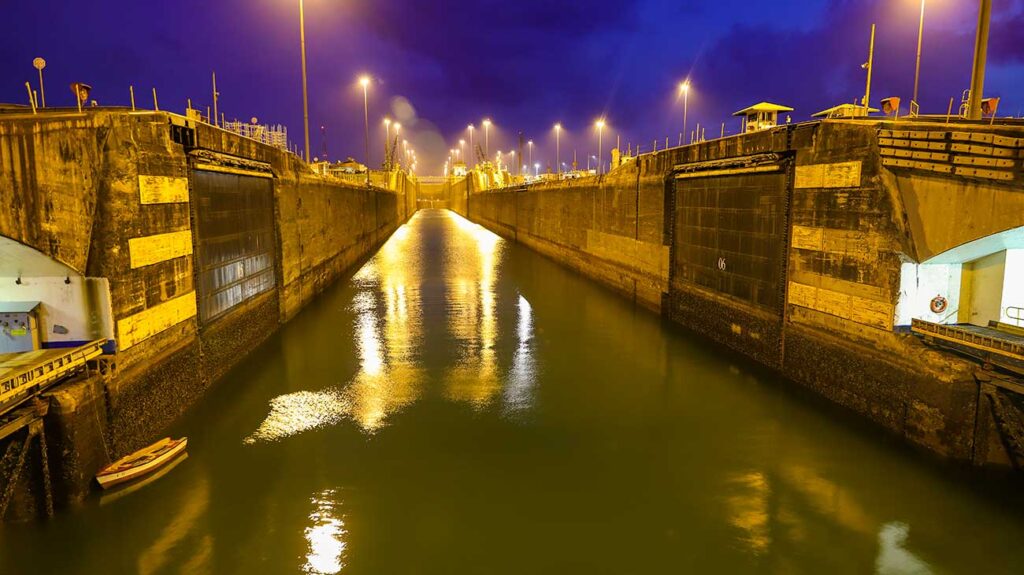It has been 31 years since the previous refurbishment of gates 13 and 14, on the middle level, and 18 years at gates 25 and 26, on the middle level, in the east lane of the Gatun Locks. In July 2021, the chamber will be dried out again so that about 400 Canal workers will be ready to perform this major maintenance.
Canal workers from the Locks, Engineering, Dredging, Industrial Shipyard and Maintenance Divisions cover two 12-hour shifts, day and night, to meet the schedule set for the execution of the project, even in rain or shine. Their planning was done years in advance, explains to El Faro, Wilfredo Yau, Reconditioning Engineer of the Locks Division, and as such, leader of the team.
The works consist of preparing the anchoring structure of the removed gates for their reinstallation, alignment of the wall plates, pouring of the concrete in the sills, and installation of the ball joints and upper anchorages of the gates in the wall, which involve civil, mechanical and surveying works.
All track reconditioning is done during the so-called “low” season, between June and September, when the number of ships in transit decreases. This planning is done years in advance. For example, we have a Master Plan that runs until 2026, and every year we update it depending on the conditions of the gates in their regular maintenance period.
Customers always know
Something that is also taken very seriously at the Panama Canal is its relationship with customers, and the policy is to keep them informed in a timely manner about any circumstance that implies the provision of continuous, safe and efficient service.
For this reason, shipping lines are notified well in advance of gate reconditioning work so that they can take their precautions.
“Notification is always made to our customers of the work to be done. Right now, the last announcement that was made to our customers covers the projects that go until December of this year; in other words, they already know what is coming and the booking conditions that can be made for this period,” Yau points out.
“The work began on the night of July 4 and should be completed by the middle of the month,” he says, as we watch the Liberian-flagged Vega Sun, a liquefied petroleum gas (LPG) tanker transiting the westbound lane on its way to the Atlantic.
“These works represent our commitment to keep this waterway working. This is a Canal that is more than 100 years old, and these Panamax Locks require maintenance. We feel committed to that, regardless of rainy or sunny weather or pandemic conditions,” Yau stresses.
Despite all these conditions and circumstances, he says, the Canal workers are motivated and willing to undertake the work, because “they are always asking me when the next project is due”.
Minor work
Since this reconditioning is carried out every 20 and 30 years, the opportunity is taken for minor works inside the chamber, such as repairing floors, cleaning all the emptying conduits of the central sewer, painting and coating the submerged components, and engineering inspections for the planning of future works.
“It is about all the culvert works, such as the improvement of the components of the culvert equipment, valves, concrete and floors, in order to have the least turbulence of the water flowing through these culverts,” says Gerardo Godoy, manager in charge of the Atlantic Locks.
The work is under the scrutiny of specialists from the Occupational Health and Safety Program. Among the four specialists, we spot the youngest of the group: Danellys Amira Diez, with only two years in the Canal’s workforce.
She explains that they work two 12-hour shifts, both day and night, in which they monitor the working conditions and ensure compliance with the protocols and standards of protection and industrial hygiene, such as the use of safety equipment and clothing, hearing protection, communication, and of course, biosecurity due to COVID-19.
For Diez, living this experience in the dry chamber is a unique experience and a source of pride. “I feel a lot of responsibility. I am extremely proud because I feel like I am making history. It is a heartfelt joy to be here and to be part of this, because it is the first time I have seen an overhaul up close. It’s quite an experience,” she says, conveying a positive energy.
Her amazement is understandable. Our first experience in reporting on dry chamber work was in the mid-1980s, at the Miraflores Locks, which we repeated almost 30 years later, in the same place. The impact was the same, with the difference that I was already a proud Canal operator.
